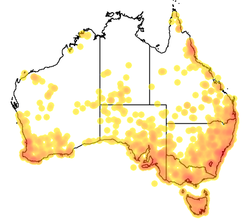Myrmecia (ant)
|
Myrmecia Temporal range: 100–0 Ma Early Cretaceous to present |
|
|---|---|
 |
|
| Bull ant queen in Swifts Creek, Victoria | |
| Scientific classification | |
| Kingdom: | Animalia |
| Phylum: | Arthropoda |
| Subphylum: | Hexapoda |
| Class: | Insecta |
| Order: | Hymenoptera |
| Superfamily: | Vespoidea |
| Family: | Formicidae |
| Subfamily: | Myrmeciinae |
| Tribe: | Myrmeciini |
| Genus: |
Myrmecia Fabricius, 1804 |
| Type species | |
|
Formica gulosa, now Myrmecia gulosa |
|
| Diversity | |
| c. 93 species | |
 |
|
| Occurrences reported to the Atlas of Living Australia as of May 2015 | |
| Synonyms | |
|
Halmamyrmecia Wheeler, 1922 |
|
Halmamyrmecia Wheeler, 1922
Pristomyrmecia Emery, 1911
Promyrmecia Emery, 1911
Myrmecia is a genus of ants first established by Danish zoologist Johan Christian Fabricius in 1804. The genus is a member of the subfamily Myrmeciinae of the family Formicidae. Myrmecia is a large genus of ants, comprising at least 93 species that are found throughout Australia and its coastal islands, while a single species is only known from New Caledonia. One species has been introduced out of its natural distribution and was found in New Zealand in 1940, but the ant was last seen in 1981. These ants are commonly known as "bulldog ants" or "jack jumper" ants, and are also associated with many other common names. They are characterised by their extreme aggressiveness, ferocity, and painful stings. Some species are known for the jumping behaviour they exhibit when agitated.
Species of this genus are also characterised by their elongated mandibles and large compound eyes that provide excellent vision. They vary in colour and size, ranging from 8 to 40 millimetres (0.31 to 1.57 in). Although workers and queens are hard to distinguish from each other due to their similar appearance, males are identifiable by their perceptibly smaller mandibles. Almost all Myrmecia species are monomorphic, with little variation among workers of a given species. Some queens are ergatoid and have no wings, while others have either stubby or completely developed wings. Nests are mostly found in soil, but they can be found in rotten wood and under rocks. One species does not nest in the ground at all; its colonies can only be found in trees.
A queen will mate with one or more males, and during colony foundation she will hunt for food until the brood have fully developed. The life cycle of the ant from egg to adult takes several months. Myrmecia workers exhibit greater longevity in comparison to other ants, and workers are also able to reproduce with male ants. Myrmecia is one of the most primitive group of ants on earth, exhibiting differentiated behaviours from other ants. Workers are solitary hunters and do not lead other workers to food. Adults are omnivores that feed on sweet substances, but the larvae are carnivores that feed on captured prey. Very few predators eat these ants due to their sting, but their larvae are often consumed by blindsnakes and echidnas, and a number of parasites infect both adults and brood. Some species are also effective pollinators.
...
Wikipedia
